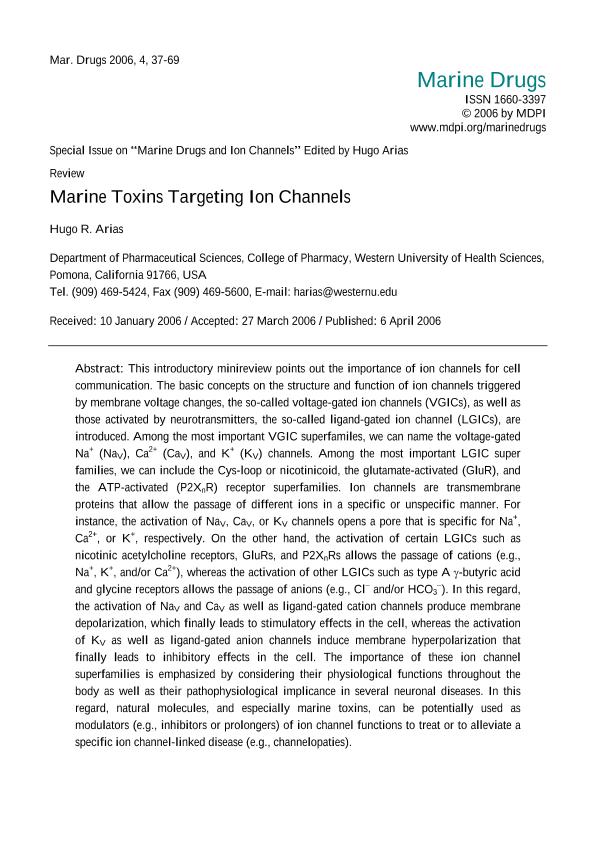Artículo
Marine Toxins Targeting Ion Channels
Fecha de publicación:
04/2006
Editorial:
Molecular Diversity Preservation International
Revista:
Marine Drugs
ISSN:
1660-3397
Idioma:
Inglés
Tipo de recurso:
Artículo publicado
Clasificación temática:
Resumen
This introductory minireview points out the importance of ion channels for cell communication. The basic concepts on the structure and function of ion channels triggered by membrane voltage changes, the so-called voltage-gated ion channels (VGICs), as well as those activated by neurotransmitters, the so-called ligand-gated ion channel (LGICs), are introduced. Among the most important VGIC superfamiles, we can name the voltage-gated Na+ (NaV), Ca2+ (CaV), and K+ (KV) channels. Among the most important LGIC super families, we can include the Cys-loop or nicotinicoid, the glutamate-activated (GluR), and the ATP-activated (P2XnR) receptor superfamilies. Ion channels are transmembrane proteins that allow the passage of different ions in a specific or unspecific manner. For instance, the activation of NaV, CaV, or KV channels opens a pore that is specific for Na+, Ca2+, or K+, respectively. On the other hand, the activation of certain LGICs such as nicotinic acetylcholine receptors, GluRs, and P2XnRs allows the passage of cations (e.g., Na+, K+, and/or Ca2+), whereas the activation of other LGICs such as type A γ-butyric acid and glycine receptors allows the passage of anions (e.g., Cl− and/or HCO3−). In this regard, the activation of NaV and CaV as well as ligand-gated cation channels produce membrane depolarization, which finally leads to stimulatory effects in the cell, whereas the activation of KV as well as ligand-gated anion channels induce membrane hyperpolarization that finally leads to inhibitory effects in the cell. The importance of these ion channel superfamilies is emphasized by considering their physiological functions throughout the body as well as their pathophysiological implicance in several neuronal diseases. In this regard, natural molecules, and especially marine toxins, can be potentially used as modulators (e.g., inhibitors or prolongers) of ion channel functions to treat or to alleviate a specific ion channel-linked disease (e.g., channelopaties).
Archivos asociados
Licencia
Identificadores
Colecciones
Articulos(INMABB)
Articulos de INST.DE MATEMATICA BAHIA BLANCA (I)
Articulos de INST.DE MATEMATICA BAHIA BLANCA (I)
Citación
Arias, Hugo Rubén; Marine Toxins Targeting Ion Channels; Molecular Diversity Preservation International; Marine Drugs; 4; 3; 4-2006; 37-69
Compartir
Altmétricas




